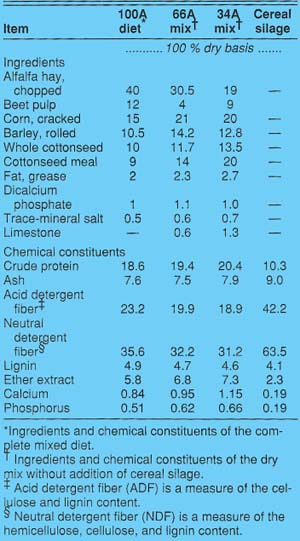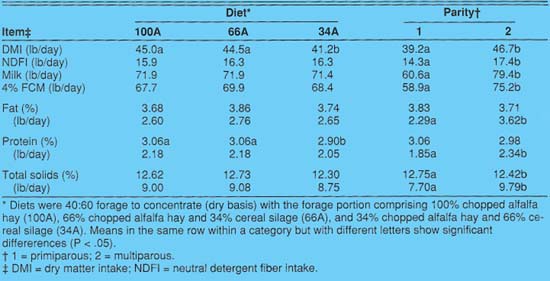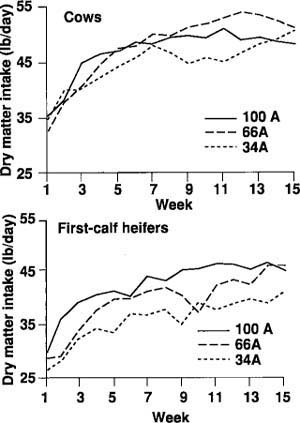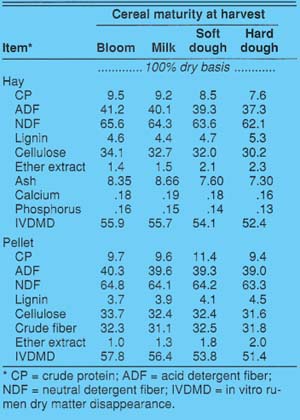All Issues
Cereal forage for dairy cattle
Publication Information
California Agriculture 44(6):21-23.
Published November 01, 1990
PDF | Citation | Permissions
Abstract
Replacing part of a dairy cow's alfalfa forage with cereal silage in early lactation did not alter milk production, but the cow's dry matter intake was reduced. The more mature the cereal was when harvested as hay, the less digestible it became. Cereal silage can be used successfully in lactation rations if harvested at an early maturity.
Full text
Growers run the chopped forage through a bagging machine (below), which ensiles the material in polyethylene silage bags (right).
Dairy operators are increasing the winter cereal content in the rations they feed to lactating dairy cows in California. These winter cereals, sometimes referred to as small-grain forages, include barley, wheat, and oats, either individually or mixed. Vetch and peas are sometimes included in the mixtures to enhance protein content. Other small grains that have received attention include rye and triticale. A number of commercial and private mixtures are available in California, so it is hard for us to generalize about winter cereal forage and address all of the questions that arise. In addition, relatively little research has concerned itself with cereal forage for lactating cows, as compared with alfalfa and corn silage.
The popularity of cereals in the forage program probably relates to the dairy producers' emphasis on reducing feed costs and optimizing the output of cows and land. In many areas of California, cereals integrate well into a double-cropping program. Small-grain cereals are planted in autumn and harvested the following spring, when the same fields are planted to corn, which in turn is harvested in autumn. Growers generally preserve the cereal forage as silage when it is intended for rations of lactating cows.
A frequent criticism of winter cereal silage relates to its poor nutritional quality, since milk yields may be reduced when rations include cereal silage. In many areas, cereals are harvested in the soft dough stage of maturity or later, generally based on oat maturity. Harvesting at the soft dough stage results in high dry-matter yield, but digestible energy and protein yields may not be optimum.
The objectives of our research were (1) to evaluate a winter forage mixture (oats, wheat, barley, and vetch) harvested at the bloom stage of maturity for the oats and preserved as silage, looking at its effects on dry matter intake and milk yield of cows during early lactation, and (2) to evaluate the effect of cereal maturity on the hay's apparent digestibility for sheep.
Methods
Dairy lactation. In the fall of 1985, we planted a commercial winter forage mixture (Germain's #2) consisting of 48.9% common oats, 19.95% barley, 14.8% common wheat, 14.75% common vetch, and 1.6% other matter. On April 25, 1986, when oats were at the bloom stage, the forage was swathed, field wilted, chopped, and ensiled in polyethylene silage bags. We estimated the forage yield of dry matter by weighing all loads of forage and subsampling the forage at bag-filling to determine dry matter content. The dry matter yield averaged 2.7 tons per acre.
One of our objectives was to measure the dry matter recovery of forage after ensiling, but vandalism to the polyethylene bags prevented this measurement. The forage was approximately 31% dry matter at ensiling. Based on visual observation, very little vetch was present in the forage at harvest.
Forty-nine lactating Holstein cows including 20 that were primiparous (first-calf heifers) and 29 that were multiparous (cows having had two or more lactations) were randomly assigned to one of three dietary treatments (table 1). Diets were 40% forage and 60% concentrate on a dry basis. All the forage in diet 100A derived from chopped alfalfa hay, 66% of the forage in diet 66A derived from chopped alfalfa hay and 34% from cereal silage, and 34% of the forage in diet 34A derived from chopped alfalfa hay and 66% from cereal silage. Each diet was fed as a complete mixed diet by hand-mixing the ingredients in each cow's feed manger.
At calving, the cows were assigned their dietary treatments, and they remained on study for the first 15 weeks of lactation. Feed was presented to the cows individually for ad libitum consumption twice daily, and feed weights were recorded. All cows were milked twice a day, milk weights were recorded, and milk was sampled for analysis of fat, protein, and total solids composition. We analyzed the data as a repeated measures design that evaluated dietary treatment, parity, and week effects.
Sheep digestion. For the sheep study, we harvested winter forage from the same field plot used for the lactation study, harvesting at four stages of oat maturity and preserving it as hay. Harvest dates and maturities were April 25 (bloom), April 30 (milk), May 8 (soft dough), and May 19 (hard dough).
We chopped and pelleted the hays, and added urea to all diets to equalize the crude protein content. We fed pellets to 16 wether sheep during a 21 -day digestion trial—a 14-day preliminary period, and 7 days of total collection of feces using collection bags and harnesses. Feed and feces were weighed, dried, and ground for chemical analysis.
The study was a randomized complete block design with the wethers grouped by body weight. We were testing for the nutrient digestibility of hays harvested at various maturities.
Results and discussion
Dairy lactation. Daily dry matter intake (DMI) was significantly lower (41.2 lb/day) for cows fed the 34A high-silage diet than for cows fed the other two diets (ca. 45 lb/day) (table 2). This may be related to the presence of a greater abundance of plant cell wall material in 34A. We estimated cell wall content as neutral detergent fiber (NDF), and diet 34A had the highest NDF concentration, though we had intended the NDF contents of all diets to be equal. Average NDF consumption was similar for cows fed the 66A and 34A diets (16.3 lb/day), but not for cows receiving the 100A diet (15.9 lb/ day). The pattern of DMI was similar for multiparous cows, though cows fed the high-silage diet tended to exhibit a lower peak intake (fig. 1). This trend was more apparent for primiparous cows.
Yields of milk and 4% fat-corrected milk were unaffected by diet (table 2). The milk yields of multiparous cows during the study were similar among groups (fig. 2). Milk yields tended to be lower for primiparous cows receiving the 34A diet during the study, and this again relates to the lower DMI of cows fed this diet. The milk's composition and yields of fat and total solids were unaffected by diet. Milk protein content was lower for cows fed the 34A diet than for those fed the other two diets, possibly a reflection of a lower energy intake.
The lactation study demonstrated that cereal silage can be fed to lactating dairy cows during early lactation, although when fed at high amounts it may reduce their feed intake and milk yield. The relationship between feed intake and milk yield will vary with the quality of the cereal silage. More cereal silage might be fed if it has been harvested at an early stage of maturity, since the quality of such forage will be higher than if the silage has been harvested later. Likewise, cereal silage harvested beyond the bloom stage would produce forage of lower quality and DMI. That would reduce the amount of cereal forage cows could consume during early lactation, and therefore reduce milk production.
Fig. 1. DMI of multiparous cows exceeded that of first-calf heifers at all diets. Both groups had lower DMIs when fed on the 34A diets.
Fig. 2. Milk yields from multiparous cows were higher than those of first-calf heifers on all diets. The low dry matter intake of heifers on the 34A diet led to lower milk yields for that group.
Sheep digestion. As the cereal forage matured, the crude protein, acid detergent fiber, neutral detergent fiber, ash, and in vitro rumen dry matter disappearance decreased (table 3). The lignin content tended to increase with advancing maturity. The decline in fiber components with advancing maturity is opposite to the trend observed for alfalfa forage. The chemical composition of the pelleted diets resembled that of the core samples from the baled hay. Crude protein of the pelleted soft dough forage was higher than intended, since we added urea to all forages as a way of equalizing the crude protein content at 10%.
Maturity at harvest affected the hay's digestibility. As the forage maturity increased, the digestibility of dry matter, organic matter, energy, crude fiber, acid detergent fiber, and neutral detergent fiber declined. Consequently, the total digestible nutrients (TDN) content of the forage declined from 48% for bloom maturity to 43.8% for hard dough maturity. We did not measure the yield of forage, so we could not determine the yield of digestible nutrients.
We regressed the chemical constituents of lignin, crude protein (CP), acid detergent fiber (ADF), neutral detergent fiber (NDF), and crude fiber (CF) against the dependent variable TDN. Correlation coefficients for TDN with lignin, CP, ADF, NDF, and CF were r = −0.75, +0.75, +0.72, +0.69, and −0.01. The negative correlation of -0.75 for lignin indicates that as TDN content of the forage decreased, lignin content of the forage increased. Likewise, the positive correlation of +0.72 for ADF indicates that as TDN content increased, ADF content increased.
These coefficients illustrate an important point. When we use prediction equations for TDN (based on fiber constituents derived from research with legumes and grasses) to predict the energy content of cereal forages, we can get erroneous results since most of these equations assume a negative relationship between plant fiber content (ADF) and energy availability. For example, the formula currently used in the California alfalfa hay testing program assumes the negative relationship between TDN and ADF represented in the formula TDN = 82.38 − (0.7515 × ADF%).
The fiber (ADF) content of grass and legume forages increases with advancing maturity, whereas the fiber in cereal forages initially increases with advancing maturity, and then either levels off or declines with further maturation. This phenomenon probably occurs because the mature grain head accounts for a greater proportion of the plant dry matter, and because some leaf and stem components are lost with advancing maturity. The sheep digestion trial demonstrated that as cereal forages become more mature, their forage quality, measured as nutrient digestibility and TDN, declines.
Conclusions
Cereal silage from small grains can be fed successfully to high-producing dairy cows. Theplants' stage of maturity at harvest affects their feed quality, with forage quality decreasing as maturity increases. Harvesting at an early stage of maturity might require extra time for field wilting because of the harvested material's higher moisture content.
In order to predict the energy content of cereal forage, researchers will have to develop new equations comparable to those used for grass and legume forages. To optimize the production output of dairy cows fed on rations that contain cereal forage, the forage should be harvested early. The decision to harvest cereals at a given stage of maturity should take into account forage quality, nutrient yields, and ensiling characteristics.











